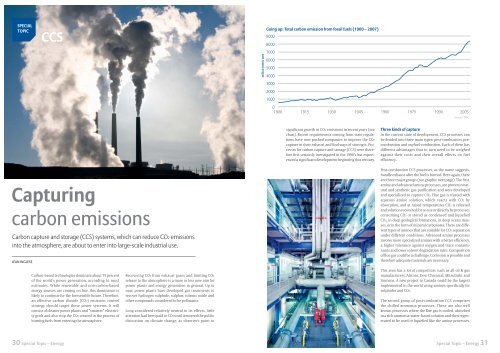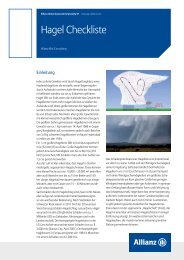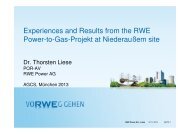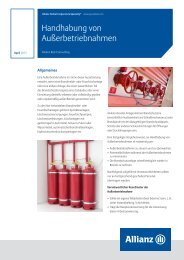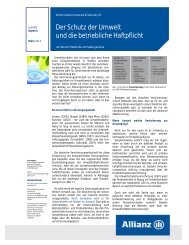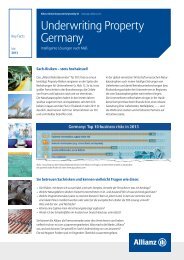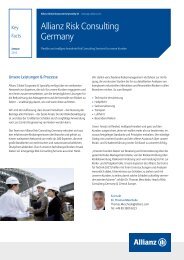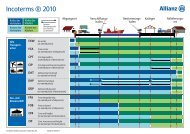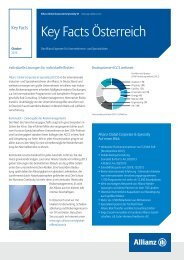Energy - Allianz Global Corporate & Specialty
Energy - Allianz Global Corporate & Specialty
Energy - Allianz Global Corporate & Specialty
Create successful ePaper yourself
Turn your PDF publications into a flip-book with our unique Google optimized e-Paper software.
SPECIAL<br />
TOPIC<br />
CCS<br />
Capturing<br />
carbon emissions<br />
Carbon capture and storage (CCS) systems, which can reduce CO2 emissions<br />
into the atmosphere, are about to enter into large-scale industrial use.<br />
JEAN INGLESE<br />
Carbon-based technologies dominate about 75 percent<br />
of the world’s power generation, according to most<br />
estimates. While renewable and non-carbon-based<br />
energy sources are coming on line, this dominance is<br />
likely to continue for the foreseeable future. Therefore,<br />
an effective carbon dioxide (CO2) emission control<br />
strategy should target these power systems. It will<br />
consist of cleaner power plants and “smarter” electricity<br />
grids and also stop the CO2 created in the process of<br />
burning fuels from entering the atmosphere.<br />
30 Special Topic – <strong>Energy</strong><br />
Recovering CO2 from exhaust gases and limiting CO2<br />
release to the atmosphere is a more or less new aim for<br />
power plants and energy generation in general. Up to<br />
now, power plants have developed gas treatments to<br />
recover hydrogen sulphide, sulphur, nitrous oxide and<br />
other compounds considered to be pollutants.<br />
Long considered relatively neutral in its effects, little<br />
attention had been paid to CO2 until it entered the public<br />
discussion on climate change, as observers point to<br />
million metric tons<br />
Going up: Total carbon emission from fossil fuels (1900 – 2007)<br />
9000<br />
8000<br />
7000<br />
6000<br />
5000<br />
4000<br />
3000<br />
2000<br />
1000<br />
0<br />
1900 1915 1930 1945 1960 1975 1990 2005<br />
significant growth in CO2 emissions in recent years (see<br />
chart). Recent requirements coming from state regula -<br />
tions have now pushed companies to improve the CO2<br />
capture in their exhaust and find ways of storing it. Processes<br />
for carbon capture and storage (CCS) were therefore<br />
first seriously investigated in the 1990’s but experienced<br />
a significant development beginning this century.<br />
Source: CDIAC<br />
Three kinds of capture<br />
In the current state of development, CCS processes can<br />
be divided into three main types: post-combustion, precombustion<br />
and oxyfuel-combustion. Each of them has<br />
different advantages that in turn need to be weighed<br />
against their costs and their overall effects on fuel<br />
efficiency.<br />
Post-combustion CCS processes, as the name suggests,<br />
handle exhaust after the fuel is burned. Here again, there<br />
are three major groups (see graphic next page). The first,<br />
amine and advanced amine processes, are proven in natural<br />
and synthetic gas purification and were developed<br />
and specialized to capture CO2. Flue gas is treated with<br />
aqueous amine solution, which reacts with CO2 by<br />
absorption, and at raised temperatures CO2 is released<br />
and solution recovered for re-use or directly by processes<br />
consuming CO2 or stored as condensed and liquefied<br />
CO2, in deep geological formations, in deep ocean masses,<br />
or in the form of mineral carbonates. There are different<br />
types of amines that are suitable for CO2 separation<br />
under different conditions. Advanced amine processes<br />
involve more specialized amines with a better efficiency,<br />
a higher tolerance against oxygen and trace contaminants<br />
and lower solvent degradation rates. Composition<br />
of flue gas could be a challenge. Corrosion is possible and<br />
therefore adequate materials are necessary.<br />
This area has a lot of competitors such as all oil & gas<br />
manufacturers, Alstom, Dow Chemical, Mitsubishi and<br />
Siemens. A new project in Canada could be the largest<br />
implemented in the world using amines specifically for<br />
sulphides and CO2.<br />
The second group of post-combustion CCS comprises<br />
the chilled ammonia processes. These are also well<br />
known processes where the flue gas is cooled, absorbed<br />
in a rich ammonia-water-based solution and then regenerated<br />
to be used or liquefied like the amine processes.<br />
Special Topic – <strong>Energy</strong> 31


